KW Bunonyo1, E. Amos2
1Department of Mathematics & Statistics, Federal University Otuoke, Otuoke, Nigeria
2Department of Mathematics, Rivers State University, Port Harcourt, Nigeria
Correspondence to: KW Bunonyo, Department of Mathematics & Statistics, Federal University Otuoke, Otuoke, Nigeria.
| Email: |  |
Copyright © 2020 The Author(s). Published by Scientific & Academic Publishing.
This work is licensed under the Creative Commons Attribution International License (CC BY).
http://creativecommons.org/licenses/by/4.0/

Abstract
This research is focused on investigating the blood flow through a sine-shaped atherosclerotic aorta with a source wall temperature and magnetic field. In the study we formulate models for the problem, scaled the governing models to be dimensionless, and reduced the coupled system to ordinary differential equations using perturbation method with an oscillation. The resulting ODEs are solved directly for velocity and temperature profiles with some pertinent parameters obtained. Mathematica codes were developed to simulate each of the functions to investigate the influence of the pertinent parameters such as radiation parameter, Hartmann number, womersley number, the treatment parameter, the wall temperature and the height of stenosis on the blood flow through an aorta that has lost its elasticity assuming the radius of the aorta as  Conclusively, we noticed that the blood velocity increases for the increase in Darcy number and treatment parameter but reversed for the increase of wall temperature, Hartmann number, womersley number, height of stenosis and oscillatory frequency parameter. The temperature profile decreases with the increase of radiation parameter, oscillatory parameter, height of stenosis and womersley number, while it increases with the increase of wall temperature and treatment parameters. Finally, the flow rate, shear stress and rate of heat transfers are also increased and decreased with the increase of radiation parameter, treatment parameter, womersley number, Hartmann number, height of stenosis and the oscillatory parameter, and this work is recommended for clinicians and other scientists/mathematicians alike who are interested in investigating blood flow through the circulation system.
Conclusively, we noticed that the blood velocity increases for the increase in Darcy number and treatment parameter but reversed for the increase of wall temperature, Hartmann number, womersley number, height of stenosis and oscillatory frequency parameter. The temperature profile decreases with the increase of radiation parameter, oscillatory parameter, height of stenosis and womersley number, while it increases with the increase of wall temperature and treatment parameters. Finally, the flow rate, shear stress and rate of heat transfers are also increased and decreased with the increase of radiation parameter, treatment parameter, womersley number, Hartmann number, height of stenosis and the oscillatory parameter, and this work is recommended for clinicians and other scientists/mathematicians alike who are interested in investigating blood flow through the circulation system.
Keywords:
Atherosclerosis, Aorta, Blood, Hartmann number, Magnetic field, Plaque, Source wall
Cite this paper: KW Bunonyo, E. Amos, Blood Flow through a Sine-Shaped Atherosclerotic Aorta with a Source Wall Temperature and Magnetic Field, American Journal of Computational and Applied Mathematics , Vol. 10 No. 2, 2020, pp. 21-38. doi: 10.5923/j.ajcam.20201002.01.
1. Background Introduction
Atherosclerosis of the aorta means that a material called plaque (fat and calcium) build up in the inside wall of a large blood vessel called the aorta. This plaque build-up is sometimes called "hardening (sclerosis) of the arteries."The aorta is the main artery that sends oxygenated blood from the heart out to the body and to the brain through the carotid artery. It runs from the heart down through to the stomach. When plaque builds up, it can cause some serious problems such as: the plaque can weaken the wall of the aorta, causes stretch or tear, pieces of the plaque can break open, which causes a blood clot to form. A blood clot or a piece of plaque can travel to other parts of your body and block or impair blood flow. The disease is sometimes symptomless and likely cause serious problems such as stroke, aortic aneurysm, aortic dissection and limb ischemia.Atherosclerosis of the aorta can be treated with lifestyle changes and medicines that help lower the risk of serious complications. These medicines include the blood pressure medicines such as ACE (angiotensin-converting enzyme) inhibitors, ARBs (angiotensin II receptor blockers), and beta-blockers, cholesterol medicines, such as statin and other medicines to lower cholesterol and medicine that prevents blood clots, such as aspirin. These medicines prevent blood clots that can cause a heart attack. One may also get a CT (computed tomography) or MRI (magnetic resonance imaging) scans to check the health of your aorta. There are some few literatures and researchers who have worked on atherosclerosis and blood flow through arterial channels using different mathematical and experimental techniques are as follows:Tang and Yang [1] studied and reported that stenosed segment of the artery may collapse because of insufficient pressure around the region of stenosis. As such it is very important to investigate the blood flow behaviour in stenosed arteries. There is a report that the shape and size of stenosis are the major parameters that significantly affect the circulation of blood. That once atherosclerosis is noticed in an arterial segment, some issues such as increase in blood flow resistance and its associated reduction in blood flow to the tissues and organs and thus could lead to serious circulation disorder [2]. The investigation of some non-Newtonian fluid flow models in addition with power law and Carreau fluid models was carried out by Cho and Kensey [3], and the results gotten were compared with the existing experimental data. Bunonyo et al [4] elucidated on lipid profile effect on blood flow in an artery channel, they formulated the flow models and solved it, performed numerical simulation using Mathematica and found in their results that the length and onset of stenosis influenced the blood flow profile. Bunonyo and Amos [5] also investigated treatment and radiation effects on oscillatory blood flow through a stensoed artery. In their model the region of stenosis is infused into the flow equation with treatment and found that the treatment parameters can actually influence heat transfer level in the blood in an arterial channel. Laminar pulsatile flow of blood under the influence of magnetic field was investigated by Mandal et al [6]. Chang et al [7] elucidated fluid-solid structure interaction between blood and solid wall modelling of blood as power law and Carreau fluids using FDM to solve the resulted differential equations. Their investigated revealed that the stress concentration is maxima at the throat of stenosis. Akbar [8] carried out a study to investigate heat and mass transfer effects in blood flow in a tapered stenotic artery, they considered blood as Carreau fluid. Vaidya et al [9] investigated heat and mass transfer analysis of MHD peristaltic flow through a compliant porous channel with variable thermal conductivity, in this model examined the influence of long wavelength and small Reynolds number and impact of thermal variable conductions and the numerical simulation were done using MATLAB. Shit and Amal [10] formulated a mathematical model to verify the role of magnetic field on blood flow and its impact on thermal behaviour of biological tissue for tumour treatment. In their study, numerical computation was performed to study the effect of static magnetic field on thermal behaviour of the tumour surrounded by living biological tissues and blood vessels and they found that the application of magnetic field increases the heat transfer rate within the tumour tissues which in turn attribute to an enhancement of temperature of about 316K or above for hyperthermia treatment of cancer therapy. Shrivastava et al [11] also examined thermal equilibrium of blood and its surrounding tissue by considering different blood vessels diameter. Pennes [12] proposed that the exchange of energy from blood tissue is proportional to the temperature difference between the blood vessel and tissue. Jimoh et al [13] studied the haematocrit and slip velocity influence on third grade blood flow and heat transfer through a stenosed artery theoretically. They considered geometry of the stenosis and put into account Galerkin weighted residual and Newton Raphson methods to solve the resulted equations that govern the flow and found that increase in magnetic field leads to decrease in velocity profile.In this present research, the investigation of blood flow through a sine-shaped atherosclerotic plaque with a source wall temperature and magnetic field. The research focuses on mathematical formulation of the problem subject to some realistic boundary condition, consideration of the treatment of cholesterol in the aorta in aiding blood flow in the system. The geometry of the plaqued wall is follows Raju and Devanathan [14], but their work did not consider the treatments, which this investigated is focusing on, in ensuring that atherosclerosis can be treated. The research aim is to solve the models to obtain the governing functions using oscillatory perturbation technique and numerically simulate the obtained functions for velocity and temperature profiles, as well as volumetric flow rate, shear stress and the rate of heat transfer by varying the important parameters and study their impact on blood circulation.
2. Mathematical Formulation
Under this section, we consider blood to be Newtonian, viscous, incompressible and electrically conducting fluid, flowing through an axially symmetric direction with a velocity , where
, where  are dimensionless coordinates in axial and perpendicular directions respectively. The channel cross sectional area under investigation is assumed to have lost its elasticity due to atherosclerosis as a result of plaque, and the plaque is assumed to be in sine-shaped form detected using lumenographic technique. The flow is also considered to be parallel due to arterial valves, and in view of the aforementioned, the Navie-Stoke equation governing the flow, energy equation and geometry of atherosclerosis are presented as follows:
are dimensionless coordinates in axial and perpendicular directions respectively. The channel cross sectional area under investigation is assumed to have lost its elasticity due to atherosclerosis as a result of plaque, and the plaque is assumed to be in sine-shaped form detected using lumenographic technique. The flow is also considered to be parallel due to arterial valves, and in view of the aforementioned, the Navie-Stoke equation governing the flow, energy equation and geometry of atherosclerosis are presented as follows:
2.1. The Continuity Equation for Blood Flow
 | (1) |
2.2. The Momentum Equation for Blood Flow
 | (2) |
2.3. The Energy Equation
 | (3) |
Atherosclerotic geometry: | (4) |
where  The above equations are subject to the following boundary conditions:
The above equations are subject to the following boundary conditions: | (5) |
We introduce the following scaling parameters: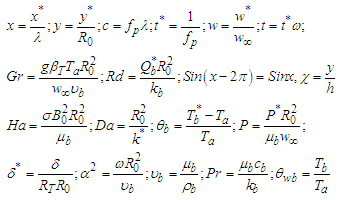 Using the scaling parameters in reducing equations (1) – (5) as follows:
Using the scaling parameters in reducing equations (1) – (5) as follows: | (6) |
 | (7) |
Modified Atherosclerotic geometry: | (8) |
where  The above equations are subject to the following boundary conditions:
The above equations are subject to the following boundary conditions: | (9) |
3. Method of Solution
In order to solve the dimensionless coupled partial differential equations, we consider the oscillatory perturbation technique to reduce the equations to ODE by assuming the solution in the form: | (10) |
Substituting equation (10) into equations (6), (7) & (9), they are reduced to the following: | (11) |
 | (12) |
Applying the transformation  in equation (11) & (12) we have:
in equation (11) & (12) we have: | (13) |
 | (14) |
where  The above equations are subject to the following boundary conditions:
The above equations are subject to the following boundary conditions: | (15) |
The general solution of equation (14) is given as: | (16) |
Solving for the function coefficient in equation (16) using equation (15), it is simplified as: | (17) |
Substitute equation (17) into equation (13), we have the following: | (18) |
where  The homogenous solution of equation (18) is given as:
The homogenous solution of equation (18) is given as: | (19) |
Let us assume the particular solution of equation (18) takes the form: | (20) |
Differentiate equation (20) to second order and substitute into equation (18), we have: | (21) |
Adding equations (19) and (21), we obtained the general solution of equation (18) as: | (22) |
Solve for the function coefficients of equation (22) using equation (15) as follows: | (23) |
We can now substitute equation (23) & (17) into equation (10), we obtained the velocity and temperature profiles as following: | (24) |
 | (25) |
The volumetric blood flow rate is mathematically stated as: | (26) |
The wall shear stress is stated mathematically as: | (27) |
The rate of heat transfer is mathematically stated as: | (28) |
4. Simulated Graphical Results
This section presents the simulated results graphical to show the influence of the various pertinent parameters on the velocity,  and temperature,
and temperature,  , as well as the volumetric flow rate,
, as well as the volumetric flow rate,  , shear stress,
, shear stress,  and rate of heat transfer,
and rate of heat transfer,  of the blood through the channel in the axial direction to validate the efficacy of the models are:
of the blood through the channel in the axial direction to validate the efficacy of the models are:  ,
,  ,
,  ,
,  ,
,  ,
,  ,
,  ,
,  ,
,  ,
,  ,
,  Shit and Amal [10],
Shit and Amal [10],  ,
,  and
and  Chato [15].
Chato [15].
5. Discussion of the Graphical Results
We shall discuss the simulated graphical results from the previous section to show the importance of the various pertinent parameters on the velocity and temperature, as well as the volumetric flow rate, shear stress and rate of heat transfer of the blood through the channel in the axial direction. The discussion follows a sequence in the form of velocity results, Figure 1 – Figure 8, the blood temperature results, Figure 9 – Figure 14, volumetric flow rate, Figure 15 – Figure 20, wall shear stress, Figure 21 – Figure 27, and rate of heat transfer, Figure 28 – Figure 33. | Figure 1. Influence of  values on velocity profile values on velocity profile |
 | Figure 2. Influence of  values on velocity profile values on velocity profile |
 | Figure 3. Influence of  values on velocity profile values on velocity profile |
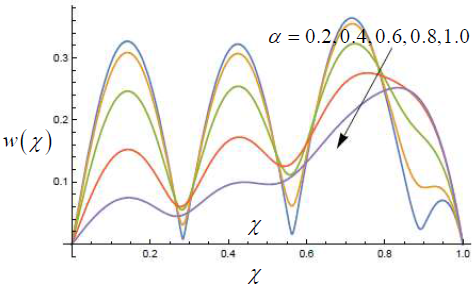 | Figure 4. Influence of  values on velocity profile values on velocity profile |
 | Figure 5. Influence of  values on velocity profile values on velocity profile |
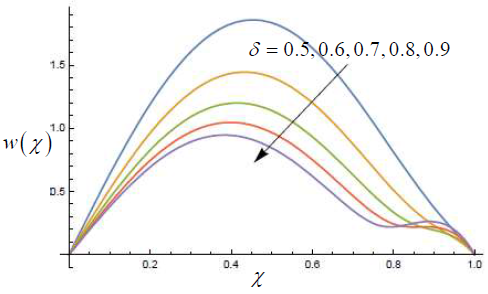 | Figure 6. Influence of  values on velocity profile values on velocity profile |
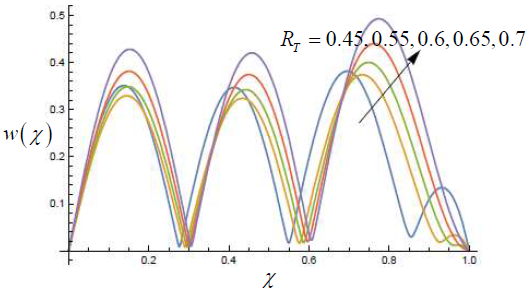 | Figure 7. Influence of  values on velocity profile values on velocity profile |
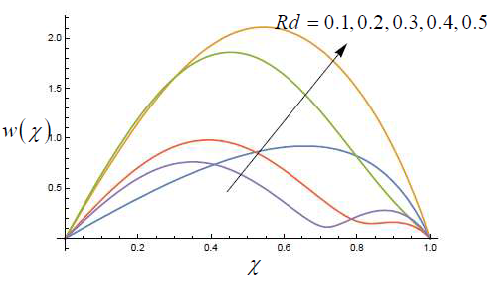 | Figure 8. Influence of  values on velocity profile values on velocity profile |
 | Figure 9. Influence of  values on temperature profile values on temperature profile |
 | Figure 10. Influence of  values on temperature profile values on temperature profile |
 | Figure 11. Influence of  values on temperature profile values on temperature profile |
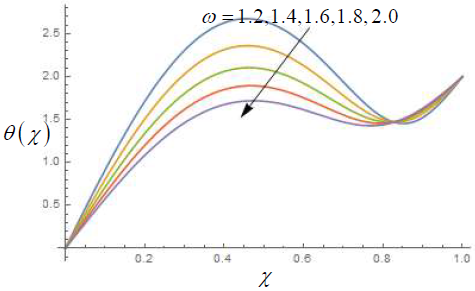 | Figure 12. Influence of  values on temperature profile values on temperature profile |
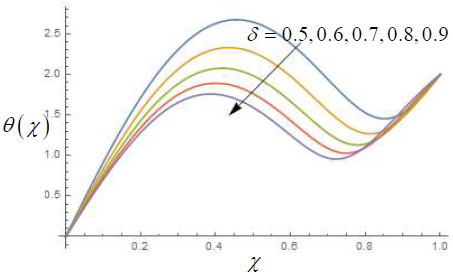 | Figure 13. Influence of  values on temperature profile values on temperature profile |
 | Figure 14. Influence of  values on temperature profile values on temperature profile |
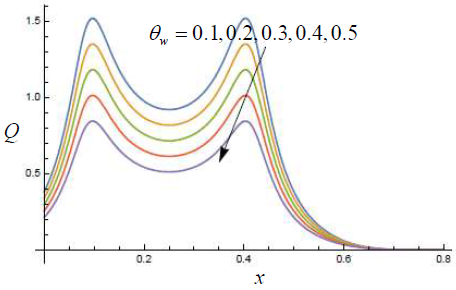 | Figure 15. Influence of  values on flow rate along axial direction values on flow rate along axial direction |
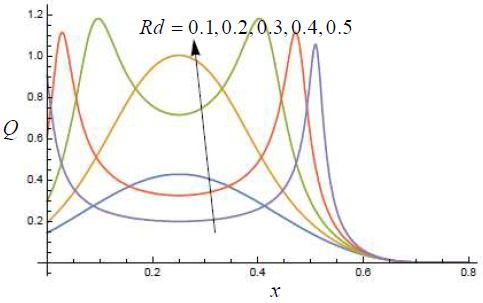 | Figure 16. Influence of  values on flow rate along axial direction values on flow rate along axial direction |
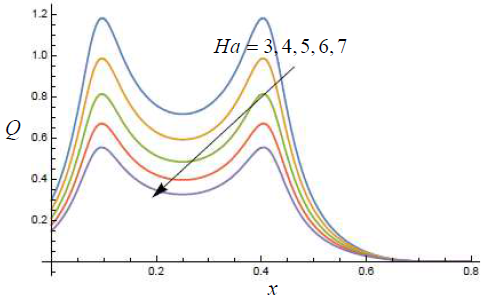 | Figure 17. Influence of  values on flow rate along axial direction values on flow rate along axial direction |
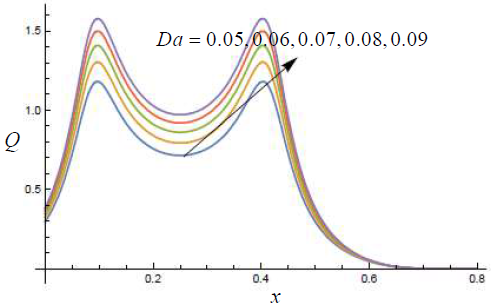 | Figure 18. Influence of  values on flow rate along axial direction values on flow rate along axial direction |
 | Figure 19. Influence of  values on flow rate along axial direction values on flow rate along axial direction |
 | Figure 20. Influence of  values on flow rate along axial direction values on flow rate along axial direction |
 | Figure 21. Influence of  values on shear stress along axial direction values on shear stress along axial direction |
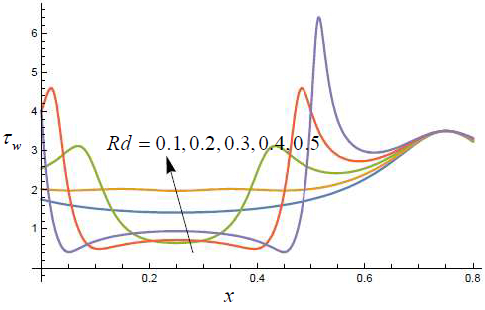 | Figure 22. Influence of  values on shear stress along axial direction values on shear stress along axial direction |
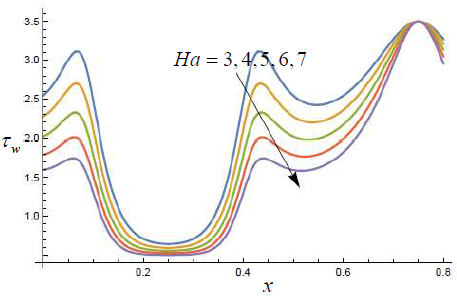 | Figure 23. Influence of  values on shear stress along axial direction values on shear stress along axial direction |
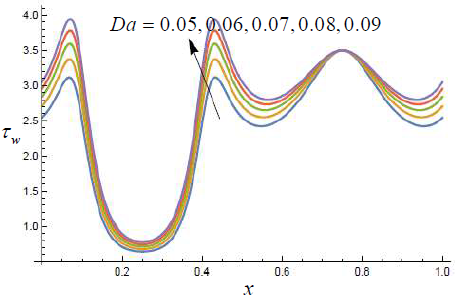 | Figure 24. Influence of  values on shear stress along axial direction values on shear stress along axial direction |
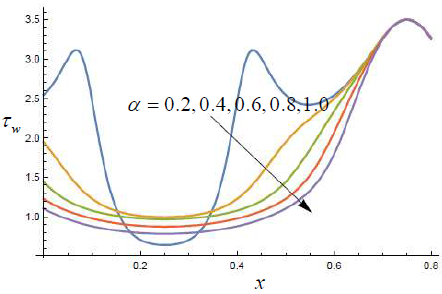 | Figure 25. Influence of  values on shear stress along axial direction values on shear stress along axial direction |
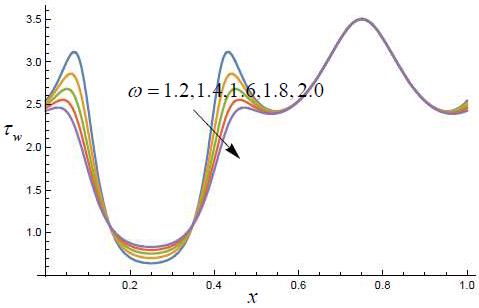 | Figure 26. Influence of  values on shear stress along axial direction values on shear stress along axial direction |
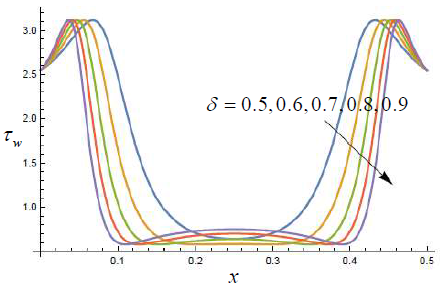 | Figure 27. Influence of  values on shear stress along axial direction values on shear stress along axial direction |
 | Figure 28. Influence of  values on rate of heat transfer along axial direction values on rate of heat transfer along axial direction |
 | Figure 29. Influence of  values on rate of heat transfer along axial direction values on rate of heat transfer along axial direction |
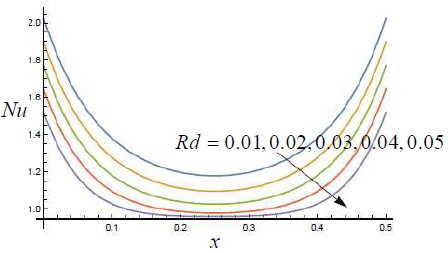 | Figure 30. Influence of  values on rate of heat transfer along axial direction values on rate of heat transfer along axial direction |
 | Figure 31. Influence of  values on rate of heat transfer along axial direction values on rate of heat transfer along axial direction |
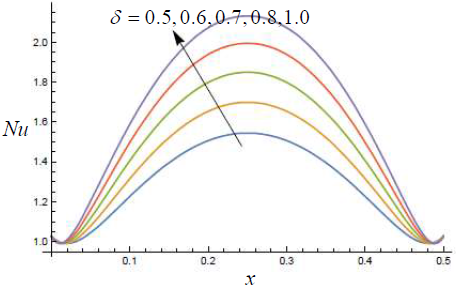 | Figure 32. Influence of  values on rate of heat transfer along axial direction values on rate of heat transfer along axial direction |
 | Figure 33. Influence of  values on rate of heat transfer along axial direction values on rate of heat transfer along axial direction |
It is observed in Figure 1 that the velocity profile decreases along the cross section as the wall temperature increase. This is so because the wall temperature increases does not make much difference in much stiffer atherosclerosis and it rather require surgical procedure to care take of such scenario. However, the velocity attained peaks between  for different values of the wall temperature before decreasing to zero as the boundary gets larger. In Figure 2 it is noticed that blood velocity profile increases as the value of Darcy number increase. This result is realistic in the sense that, the porosity increase aided the velocity increase before decreasing as the boundary layer grows. This result clearly showed different peak for different level of porosity along artery within
for different values of the wall temperature before decreasing to zero as the boundary gets larger. In Figure 2 it is noticed that blood velocity profile increases as the value of Darcy number increase. This result is realistic in the sense that, the porosity increase aided the velocity increase before decreasing as the boundary layer grows. This result clearly showed different peak for different level of porosity along artery within  with the other pertinent parameters values. Figure 3 depicts that the velocity profile decreases by increasing the values of the Hartmann number. This is because when a magnetic field strength of between
with the other pertinent parameters values. Figure 3 depicts that the velocity profile decreases by increasing the values of the Hartmann number. This is because when a magnetic field strength of between  applied to a flowing electrically conducting fluid such blood it generate a force called the Lorentz force which opposes the flow. However, the oscillatory behaviour of this result is as a result of pumping rate of the heart.Figure 4 illustrates that increase in womersley number
applied to a flowing electrically conducting fluid such blood it generate a force called the Lorentz force which opposes the flow. However, the oscillatory behaviour of this result is as a result of pumping rate of the heart.Figure 4 illustrates that increase in womersley number  , decreases the blood velocity profile which gives upper influence to the inertia force over the viscous force as the fluid flow in the arterial segment. The oscillatory behaviour of the result is the due to the pumping rate of the heart with the other pertinent parameters stated in section 4. The influence of the oscillatory parameter was investigated with outcome shown in Figure 5, and the figure show that increase the oscillatory frequency parameter, resulted to the decrease in velocity profile.Figure 6 clearly showed that as the height of stenosis increases as a result of the increase in the risk factor of atherosclerosis, the more the velocity reduces owing to the factor that increase thickens the stenosed region but velocity attains maximum between
, decreases the blood velocity profile which gives upper influence to the inertia force over the viscous force as the fluid flow in the arterial segment. The oscillatory behaviour of the result is the due to the pumping rate of the heart with the other pertinent parameters stated in section 4. The influence of the oscillatory parameter was investigated with outcome shown in Figure 5, and the figure show that increase the oscillatory frequency parameter, resulted to the decrease in velocity profile.Figure 6 clearly showed that as the height of stenosis increases as a result of the increase in the risk factor of atherosclerosis, the more the velocity reduces owing to the factor that increase thickens the stenosed region but velocity attains maximum between  with the other pertinent parameters as stated in section 4. It is seen in Figures 7 & 8 that the increase in the treatment and radiation parameters values
with the other pertinent parameters as stated in section 4. It is seen in Figures 7 & 8 that the increase in the treatment and radiation parameters values  &
&  increases the velocity of the fluid.It is observed in Figure 10 – Figure 13 that increase in radiation, womersley, oscillatory frequency and height of stenosis parameters influenced the temperature profile to decrease, while Figure 9 and Figure 14 depict an increase in velocity profile holding the other variables values constant. The volumetric flow was investigated by varying the values of
increases the velocity of the fluid.It is observed in Figure 10 – Figure 13 that increase in radiation, womersley, oscillatory frequency and height of stenosis parameters influenced the temperature profile to decrease, while Figure 9 and Figure 14 depict an increase in velocity profile holding the other variables values constant. The volumetric flow was investigated by varying the values of  and
and  in Figure 15, Figure 17, Figure 19 and Figure 20, and we noticed that increase in the aforementioned parameters values, decreases the volumetric flow rate with other parameters values. Main while, the flow rate increases by increasing the values of the wall temperature and Darcy number respectively. The wall shear stress was investigated with graphical results shown in Figure 21 to Figure 27. In Figures 21, 23, 25, 26 and 27, we noticed a decrease in shear stress as a result of the increase in the values of
in Figure 15, Figure 17, Figure 19 and Figure 20, and we noticed that increase in the aforementioned parameters values, decreases the volumetric flow rate with other parameters values. Main while, the flow rate increases by increasing the values of the wall temperature and Darcy number respectively. The wall shear stress was investigated with graphical results shown in Figure 21 to Figure 27. In Figures 21, 23, 25, 26 and 27, we noticed a decrease in shear stress as a result of the increase in the values of  and
and  , while the stress increases for the increase in Darcy number and radiation parameters, while we maintain the values of the other pertinent parameters as stated in section 4.Figure 31 – Figure 33 show the results of pertinent parameters on the rate of heat transfer, it is seen that oscillatory frequency parameter, height of stenosis, and treatment parameters increases resulted to an increase in the rate of heat transfer, while Figure 28 – Figure 30 depicts a decrease in rate of heat transfer as a result of the increase in wall temperature, womersley number and radiation parameter.
, while the stress increases for the increase in Darcy number and radiation parameters, while we maintain the values of the other pertinent parameters as stated in section 4.Figure 31 – Figure 33 show the results of pertinent parameters on the rate of heat transfer, it is seen that oscillatory frequency parameter, height of stenosis, and treatment parameters increases resulted to an increase in the rate of heat transfer, while Figure 28 – Figure 30 depicts a decrease in rate of heat transfer as a result of the increase in wall temperature, womersley number and radiation parameter.
6. Conclusions
The aim of this research is to study blood flow through a sine-shaped atherosclerotic plaque with a source wall temperature and magnetic field using mathematical models. The exact solutions were obtained for the velocity and temperature profiles after scaling the governing equations and adopting oscillatory perturbation. The resulted functions are simulated with some pertinent variable parameters using Mathematica, and we conclude the following observations:(a) The velocity of blood decreases considerably with the increase in the wall temperature  , the Hartmann number
, the Hartmann number  , oscillatory parameter
, oscillatory parameter  , the height of stenosis
, the height of stenosis  and the womersley number,
and the womersley number,  , and it increases marginally with the increase of Darcy number
, and it increases marginally with the increase of Darcy number  and the treatment parameter
and the treatment parameter  .(b) The temperature distribution increases with the increase of the wall temperature
.(b) The temperature distribution increases with the increase of the wall temperature  and the treatment parameter
and the treatment parameter  while it decreases with the increase of radiation parameter
while it decreases with the increase of radiation parameter  , womersley parameter
, womersley parameter  , oscillatory parameter
, oscillatory parameter  and height of stenosis
and height of stenosis  .(c) The volumetric blood flow rate decreases with the increase of
.(c) The volumetric blood flow rate decreases with the increase of  , Hartmann number
, Hartmann number  , oscillatory parameter
, oscillatory parameter  and the height of the stenosis
and the height of the stenosis  while it increases with the increase of the radiation parameter
while it increases with the increase of the radiation parameter  , the Darcy parameter
, the Darcy parameter  .(d) The shear stress of blood at the vessel wall increases considerably with the increase of the radiation parameter
.(d) The shear stress of blood at the vessel wall increases considerably with the increase of the radiation parameter  and the Darcy number
and the Darcy number  , while it decreases with the increase of the wall temperature
, while it decreases with the increase of the wall temperature  , the Hartmann number
, the Hartmann number  , the womersley number
, the womersley number  , the oscillatory parameter
, the oscillatory parameter  and the stenostic height
and the stenostic height  .(e) The rate of heat transfer increases with the increase of the oscillatory parameter
.(e) The rate of heat transfer increases with the increase of the oscillatory parameter  , the height of stenosis
, the height of stenosis  and the treatment parameter
and the treatment parameter  , while it decreases with the increase of wall temperature parameter
, while it decreases with the increase of wall temperature parameter  , womersley number
, womersley number  and the radiation parameter
and the radiation parameter  .Given the above points, we can finally conclude that blood flow situation can be accurately determined by knowing the flow profile of an individual. This investigation made known the importance of early treatment in ailment related to cardiovascular challenges such as atherosclerosis and the use of heat in the form of massaging in aiding blood flow in constricted area of an aorta in order to break the molecular bond within that area in supporting life. The study will be of interest to clinicians and researchers who are involved in the treatment of cancer and other tumour ill conditions.
.Given the above points, we can finally conclude that blood flow situation can be accurately determined by knowing the flow profile of an individual. This investigation made known the importance of early treatment in ailment related to cardiovascular challenges such as atherosclerosis and the use of heat in the form of massaging in aiding blood flow in constricted area of an aorta in order to break the molecular bond within that area in supporting life. The study will be of interest to clinicians and researchers who are involved in the treatment of cancer and other tumour ill conditions.
Nomenclature
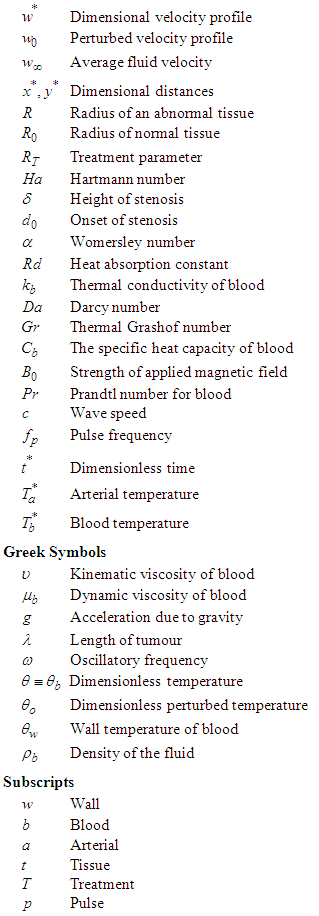
References
| [1] | Tang, D., Yang, C., Kobayashi, S., & Ku, D. N. (2001). Generalized finite difference method for 3-D viscous flow in stenotic tubes with large wall deformation and collapse. Applied numerical mathematics, 38(1-2), 49-68. |
| [2] | Mekheimer, K. S., & El Kot, M. A. (2012). Mathematical modelling of unsteady flow of a Sisko fluid through an anisotropically tapered elastic arteries with time-variant overlapping stenosis. Applied Mathematical Modelling, 36(11), 5393-5407. |
| [3] | Cho, Y. I., & Kensey, K. R. (1989). Effects of the non-Newtonian viscosity of blood on hemodynamics of diiseased arterial flows (Vol. 1, pp. 3-4). Prat. |
| [4] | Kubugha Wilcox Bunonyo & Emeka Amos. Lipid Concentration Effect on Blood Flow Through an Inclined Arterial Channel with Magnetic Field. Mathematical Modelling and Applications. Vol. 5, No. 3, 2020, pp. 129-137. doi: 10.11648/j.mma.20200503.11 |
| [5] | Bunonyo, K.W., & Amos, E. (2020). "Investigation of the Treatment and Radiation Effects on Oscillatory Blood Flow through a Stenosed Artery.” American Journal of Engineering Research (AJER), vol. 9(04), pp. 253-259. |
| [6] | Mandal, P. K., Chakravarty, S., Mandal, A., & Amin, N. (2007). Effect of body acceleration on unsteady pulsatile flow of non-Newtonian fluid through a stenosed artery. Applied Mathematics and Computation, 189(1), 766-779. |
| [7] | Chan, W. Y., Ding, Y., & Tu, J. Y. (2005). Modeling of non-Newtonian blood flow through a stenosed artery incorporating fluid-structure interaction. Anziam Journal, 47, 507-523. |
| [8] | Akbar, N. S. (2014). Heat and mass transfer effects on Carreau fluid model for blood flow through a tapered artery with a stenosis. International Journal of Biomathematics, 7(01), 1450004. |
| [9] | Vaidya, H., Choudhari, R., Gudekote, M., Prasad, K. V., Makinde, O. D., & Vajravel, K. (2020). Heat and mass transfer analysis of MHD peristaltic flow through a complaint porous channel with variable thermal conductivity. Physica Scripta. |
| [10] | Shit, G. C., & Bera, A. (2020). Mathematical model to verify the role of magnetic field on blood flow and its impact on thermal behavior of biological tissue for tumor treatment. Biomedical Physics & Engineering Express, 6(1), 015032. |
| [11] | Shrivastava, D., & Roemer, R. B. (2006). Readdressing the issue of thermally significant blood vessels using a countercurrent vessel network. |
| [12] | Pennes, H. H. (1948). Analysis of tissue and arterial blood temperatures in the resting human forearm. Journal of applied physiology, 1(2), 93-122. |
| [13] | Jimoh, A., Okedayo, G. T., & Aboiyar, T. (2019). Hematocrit and Slip Velocity Influence on Third Grade Blood Flow and Heat Transfer through a Stenosed Artery. Journal of Applied Mathematics and Physics, 7(3), 638-663. |
| [14] | Raju, K. K., & Devanathan, R. (1972). Peristaltic motion of a non-Newtonian fluid. Rheologica Acta, 11(2), 170-178. |
| [15] | Chato JC (1980), Heat transfer to blood vessels. J Biomech Eng 102: 110-118. |



 Conclusively, we noticed that the blood velocity increases for the increase in Darcy number and treatment parameter but reversed for the increase of wall temperature, Hartmann number, womersley number, height of stenosis and oscillatory frequency parameter. The temperature profile decreases with the increase of radiation parameter, oscillatory parameter, height of stenosis and womersley number, while it increases with the increase of wall temperature and treatment parameters. Finally, the flow rate, shear stress and rate of heat transfers are also increased and decreased with the increase of radiation parameter, treatment parameter, womersley number, Hartmann number, height of stenosis and the oscillatory parameter, and this work is recommended for clinicians and other scientists/mathematicians alike who are interested in investigating blood flow through the circulation system.
Conclusively, we noticed that the blood velocity increases for the increase in Darcy number and treatment parameter but reversed for the increase of wall temperature, Hartmann number, womersley number, height of stenosis and oscillatory frequency parameter. The temperature profile decreases with the increase of radiation parameter, oscillatory parameter, height of stenosis and womersley number, while it increases with the increase of wall temperature and treatment parameters. Finally, the flow rate, shear stress and rate of heat transfers are also increased and decreased with the increase of radiation parameter, treatment parameter, womersley number, Hartmann number, height of stenosis and the oscillatory parameter, and this work is recommended for clinicians and other scientists/mathematicians alike who are interested in investigating blood flow through the circulation system.
 , where
, where  are dimensionless coordinates in axial and perpendicular directions respectively. The channel cross sectional area under investigation is assumed to have lost its elasticity due to atherosclerosis as a result of plaque, and the plaque is assumed to be in sine-shaped form detected using lumenographic technique. The flow is also considered to be parallel due to arterial valves, and in view of the aforementioned, the Navie-Stoke equation governing the flow, energy equation and geometry of atherosclerosis are presented as follows:
are dimensionless coordinates in axial and perpendicular directions respectively. The channel cross sectional area under investigation is assumed to have lost its elasticity due to atherosclerosis as a result of plaque, and the plaque is assumed to be in sine-shaped form detected using lumenographic technique. The flow is also considered to be parallel due to arterial valves, and in view of the aforementioned, the Navie-Stoke equation governing the flow, energy equation and geometry of atherosclerosis are presented as follows:



 The above equations are subject to the following boundary conditions:
The above equations are subject to the following boundary conditions:
 Using the scaling parameters in reducing equations (1) – (5) as follows:
Using the scaling parameters in reducing equations (1) – (5) as follows:


 The above equations are subject to the following boundary conditions:
The above equations are subject to the following boundary conditions:



 in equation (11) & (12) we have:
in equation (11) & (12) we have:

 The above equations are subject to the following boundary conditions:
The above equations are subject to the following boundary conditions:



 The homogenous solution of equation (18) is given as:
The homogenous solution of equation (18) is given as:









 and temperature,
and temperature,  , as well as the volumetric flow rate,
, as well as the volumetric flow rate,  , shear stress,
, shear stress,  and rate of heat transfer,
and rate of heat transfer,  of the blood through the channel in the axial direction to validate the efficacy of the models are:
of the blood through the channel in the axial direction to validate the efficacy of the models are:  ,
,  ,
,  ,
,  ,
,  ,
,  ,
,  ,
,  ,
,  ,
,  ,
,  Shit and Amal [10],
Shit and Amal [10],  ,
,  and
and  Chato [15].
Chato [15].
 values on velocity profile
values on velocity profile
 values on velocity profile
values on velocity profile
 values on velocity profile
values on velocity profile
 values on velocity profile
values on velocity profile
 values on velocity profile
values on velocity profile
 values on velocity profile
values on velocity profile
 values on velocity profile
values on velocity profile
 values on velocity profile
values on velocity profile
 values on temperature profile
values on temperature profile
 values on temperature profile
values on temperature profile
 values on temperature profile
values on temperature profile
 values on temperature profile
values on temperature profile
 values on temperature profile
values on temperature profile
 values on temperature profile
values on temperature profile
 values on flow rate along axial direction
values on flow rate along axial direction
 values on flow rate along axial direction
values on flow rate along axial direction
 values on flow rate along axial direction
values on flow rate along axial direction
 values on flow rate along axial direction
values on flow rate along axial direction
 values on flow rate along axial direction
values on flow rate along axial direction
 values on flow rate along axial direction
values on flow rate along axial direction
 values on shear stress along axial direction
values on shear stress along axial direction
 values on shear stress along axial direction
values on shear stress along axial direction
 values on shear stress along axial direction
values on shear stress along axial direction
 values on shear stress along axial direction
values on shear stress along axial direction
 values on shear stress along axial direction
values on shear stress along axial direction
 values on shear stress along axial direction
values on shear stress along axial direction
 values on shear stress along axial direction
values on shear stress along axial direction
 values on rate of heat transfer along axial direction
values on rate of heat transfer along axial direction
 values on rate of heat transfer along axial direction
values on rate of heat transfer along axial direction
 values on rate of heat transfer along axial direction
values on rate of heat transfer along axial direction
 values on rate of heat transfer along axial direction
values on rate of heat transfer along axial direction
 values on rate of heat transfer along axial direction
values on rate of heat transfer along axial direction
 values on rate of heat transfer along axial direction
values on rate of heat transfer along axial direction for different values of the wall temperature before decreasing to zero as the boundary gets larger. In Figure 2 it is noticed that blood velocity profile increases as the value of Darcy number increase. This result is realistic in the sense that, the porosity increase aided the velocity increase before decreasing as the boundary layer grows. This result clearly showed different peak for different level of porosity along artery within
for different values of the wall temperature before decreasing to zero as the boundary gets larger. In Figure 2 it is noticed that blood velocity profile increases as the value of Darcy number increase. This result is realistic in the sense that, the porosity increase aided the velocity increase before decreasing as the boundary layer grows. This result clearly showed different peak for different level of porosity along artery within  with the other pertinent parameters values. Figure 3 depicts that the velocity profile decreases by increasing the values of the Hartmann number. This is because when a magnetic field strength of between
with the other pertinent parameters values. Figure 3 depicts that the velocity profile decreases by increasing the values of the Hartmann number. This is because when a magnetic field strength of between  applied to a flowing electrically conducting fluid such blood it generate a force called the Lorentz force which opposes the flow. However, the oscillatory behaviour of this result is as a result of pumping rate of the heart.Figure 4 illustrates that increase in womersley number
applied to a flowing electrically conducting fluid such blood it generate a force called the Lorentz force which opposes the flow. However, the oscillatory behaviour of this result is as a result of pumping rate of the heart.Figure 4 illustrates that increase in womersley number  , decreases the blood velocity profile which gives upper influence to the inertia force over the viscous force as the fluid flow in the arterial segment. The oscillatory behaviour of the result is the due to the pumping rate of the heart with the other pertinent parameters stated in section 4. The influence of the oscillatory parameter was investigated with outcome shown in Figure 5, and the figure show that increase the oscillatory frequency parameter, resulted to the decrease in velocity profile.Figure 6 clearly showed that as the height of stenosis increases as a result of the increase in the risk factor of atherosclerosis, the more the velocity reduces owing to the factor that increase thickens the stenosed region but velocity attains maximum between
, decreases the blood velocity profile which gives upper influence to the inertia force over the viscous force as the fluid flow in the arterial segment. The oscillatory behaviour of the result is the due to the pumping rate of the heart with the other pertinent parameters stated in section 4. The influence of the oscillatory parameter was investigated with outcome shown in Figure 5, and the figure show that increase the oscillatory frequency parameter, resulted to the decrease in velocity profile.Figure 6 clearly showed that as the height of stenosis increases as a result of the increase in the risk factor of atherosclerosis, the more the velocity reduces owing to the factor that increase thickens the stenosed region but velocity attains maximum between  with the other pertinent parameters as stated in section 4. It is seen in Figures 7 & 8 that the increase in the treatment and radiation parameters values
with the other pertinent parameters as stated in section 4. It is seen in Figures 7 & 8 that the increase in the treatment and radiation parameters values  &
&  increases the velocity of the fluid.It is observed in Figure 10 – Figure 13 that increase in radiation, womersley, oscillatory frequency and height of stenosis parameters influenced the temperature profile to decrease, while Figure 9 and Figure 14 depict an increase in velocity profile holding the other variables values constant. The volumetric flow was investigated by varying the values of
increases the velocity of the fluid.It is observed in Figure 10 – Figure 13 that increase in radiation, womersley, oscillatory frequency and height of stenosis parameters influenced the temperature profile to decrease, while Figure 9 and Figure 14 depict an increase in velocity profile holding the other variables values constant. The volumetric flow was investigated by varying the values of  and
and  in Figure 15, Figure 17, Figure 19 and Figure 20, and we noticed that increase in the aforementioned parameters values, decreases the volumetric flow rate with other parameters values. Main while, the flow rate increases by increasing the values of the wall temperature and Darcy number respectively. The wall shear stress was investigated with graphical results shown in Figure 21 to Figure 27. In Figures 21, 23, 25, 26 and 27, we noticed a decrease in shear stress as a result of the increase in the values of
in Figure 15, Figure 17, Figure 19 and Figure 20, and we noticed that increase in the aforementioned parameters values, decreases the volumetric flow rate with other parameters values. Main while, the flow rate increases by increasing the values of the wall temperature and Darcy number respectively. The wall shear stress was investigated with graphical results shown in Figure 21 to Figure 27. In Figures 21, 23, 25, 26 and 27, we noticed a decrease in shear stress as a result of the increase in the values of  and
and  , while the stress increases for the increase in Darcy number and radiation parameters, while we maintain the values of the other pertinent parameters as stated in section 4.Figure 31 – Figure 33 show the results of pertinent parameters on the rate of heat transfer, it is seen that oscillatory frequency parameter, height of stenosis, and treatment parameters increases resulted to an increase in the rate of heat transfer, while Figure 28 – Figure 30 depicts a decrease in rate of heat transfer as a result of the increase in wall temperature, womersley number and radiation parameter.
, while the stress increases for the increase in Darcy number and radiation parameters, while we maintain the values of the other pertinent parameters as stated in section 4.Figure 31 – Figure 33 show the results of pertinent parameters on the rate of heat transfer, it is seen that oscillatory frequency parameter, height of stenosis, and treatment parameters increases resulted to an increase in the rate of heat transfer, while Figure 28 – Figure 30 depicts a decrease in rate of heat transfer as a result of the increase in wall temperature, womersley number and radiation parameter.  , the Hartmann number
, the Hartmann number  , oscillatory parameter
, oscillatory parameter  , the height of stenosis
, the height of stenosis  and the womersley number,
and the womersley number,  , and it increases marginally with the increase of Darcy number
, and it increases marginally with the increase of Darcy number  and the treatment parameter
and the treatment parameter  .(b) The temperature distribution increases with the increase of the wall temperature
.(b) The temperature distribution increases with the increase of the wall temperature  and the treatment parameter
and the treatment parameter  while it decreases with the increase of radiation parameter
while it decreases with the increase of radiation parameter  , womersley parameter
, womersley parameter  , oscillatory parameter
, oscillatory parameter  and height of stenosis
and height of stenosis  .(c) The volumetric blood flow rate decreases with the increase of
.(c) The volumetric blood flow rate decreases with the increase of  , Hartmann number
, Hartmann number  , oscillatory parameter
, oscillatory parameter  and the height of the stenosis
and the height of the stenosis  while it increases with the increase of the radiation parameter
while it increases with the increase of the radiation parameter  , the Darcy parameter
, the Darcy parameter  .(d) The shear stress of blood at the vessel wall increases considerably with the increase of the radiation parameter
.(d) The shear stress of blood at the vessel wall increases considerably with the increase of the radiation parameter  and the Darcy number
and the Darcy number  , while it decreases with the increase of the wall temperature
, while it decreases with the increase of the wall temperature  , the Hartmann number
, the Hartmann number  , the womersley number
, the womersley number  , the oscillatory parameter
, the oscillatory parameter  and the stenostic height
and the stenostic height  .(e) The rate of heat transfer increases with the increase of the oscillatory parameter
.(e) The rate of heat transfer increases with the increase of the oscillatory parameter  , the height of stenosis
, the height of stenosis  and the treatment parameter
and the treatment parameter  , while it decreases with the increase of wall temperature parameter
, while it decreases with the increase of wall temperature parameter  , womersley number
, womersley number  and the radiation parameter
and the radiation parameter  .Given the above points, we can finally conclude that blood flow situation can be accurately determined by knowing the flow profile of an individual. This investigation made known the importance of early treatment in ailment related to cardiovascular challenges such as atherosclerosis and the use of heat in the form of massaging in aiding blood flow in constricted area of an aorta in order to break the molecular bond within that area in supporting life. The study will be of interest to clinicians and researchers who are involved in the treatment of cancer and other tumour ill conditions.
.Given the above points, we can finally conclude that blood flow situation can be accurately determined by knowing the flow profile of an individual. This investigation made known the importance of early treatment in ailment related to cardiovascular challenges such as atherosclerosis and the use of heat in the form of massaging in aiding blood flow in constricted area of an aorta in order to break the molecular bond within that area in supporting life. The study will be of interest to clinicians and researchers who are involved in the treatment of cancer and other tumour ill conditions.
 Abstract
Abstract Reference
Reference Full-Text PDF
Full-Text PDF Full-text HTML
Full-text HTML